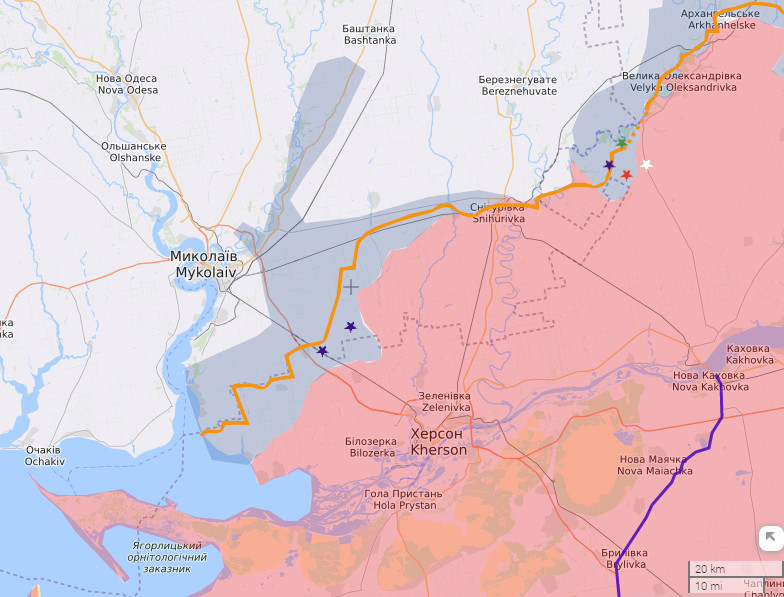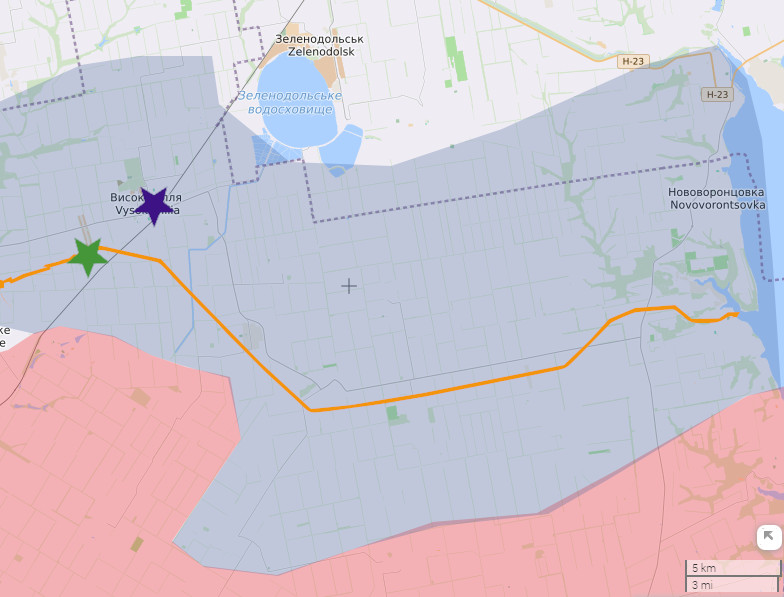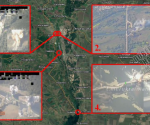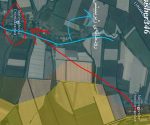Russia shoots bullets, Ukraine dances; or Kherson and Kharkov: the aftermath
The Ukrainian propaganda outlets also known as pro-Russian social media OSINT-mongers excelled themselves yesterday by announcing that there had been a “breakthrough” of the Russian defence at Davydov Brod in Kherson (read about why this place is locally important, here). Later, a correction was made, with details: an attack with 60 infantry, reinforced by 4 BMPs (infantry fighting vehicles) and 3 tanks was repulsed, the Ukrainians retreated with losses. “Pro-Russian” Twitter-Telegram twaterati do this sort of thing over again.
For example, an account called @RVvoenkor reported no less than five attempted Ukrainian attacks in one post: the first was underway at Krasny Liman (to be announced as failed later), and others had preceded it: at Shchurovo (repulsed), at Yampol (unsuccessful), at Gorlovka (foiled), at Peski and Pervomayskoye (prevented). It doesn’t take much to imagine all the extraordinarily excessive twitching that would have been caused in the idiotic audience of this message, unable to learn, as they obviously are, from one crisis with resolution to the next.
In a moment, there is going to be a presentation of material that suggests what the fate of one of these Ukrainian attacks is always going to be – even if it is executed by 60 men.
While some so-called luminaries of alternative media geopolitical analysis have hedged their bets, the consensus of opinion amongst the exclusive echelons of brand name expertise is that Russia was caught out by a Ukrainian “offensive” in Kharkov. A slew of material expressing concern conveniently coincides with the twaterati reporting an “accumulation of forces and equipment of Ukraine near the line of contact in the Zaporozhye region [which] is colossal”. Evidently, by the reckoning of a galaxy of alt-media stars, being unable to detect that which is common knowledge amongst a lot of morons via their media devices means that Russian forces are at risk of being surprised by another “offensive”.
On the contrary, the following presentation is intended to promote the occurrence in the reader of the realisation that it was highly unlikely – nay, impossible – that Russian armed forces did not have the necessary capability to be aware of enemy strength, and its potential, in Kharkov ahead of the Charge of the NATO-Ukrainians as happened there this past week.
Below is a number of images taken from Russian MoD (RMoD) briefings from the 11th, 12th and 13th of September, and accompanying each is the textual detail explaining what, in part, is being shown. The intention is to make a list of otherwise dislocated place names meaningful, so that the reader can visualise where the Ukrainian casualties reported in the briefing are happening. Please note that the extracts published here are but a contingent of the overall Russian activity for said dates and does not represent it in its entirety. The particular examples used here have been selected for a demonstrative purpose and a discourse will follow regarding that.
* * * * *
^ – 11th September – 1: Russian Aerospace Forces, missile forces, and artillery targeted the Ukrainian 14th and 92nd Mechanized Brigades in the areas of Staroverovka, Chuguev and Volosskaya Balakleya, and the 113th Territorial Defence Brigade in Novaya Vodolaga, as well as foreign mercenaries near Klugino-Bashkirovka. 200 servicemen and more than 20 units of military equipment had been “eliminated”.
^ – 11th September – 2: “concentrated fire strikes” targeted Ukrainian forces in the areas of Pristin, Boldyrevka, Sinikha, Beloye, Komarovka, Gorokhovatka, Kupyansk, Senkovo, and Podvysokoye in the Kharkov region. “More than 250 Ukrainian servicemen, 12 units of armored vehicles, three field artillery guns, one multiple-launch rocket system and 17 motor vehicles were destroyed.”
^ – 11th September – 3: The Russian Air Force attacked a temporary deployment of the 36th Brigade Ukrainian Marine Corps near Nikolayev (Mikolaiv). More than 100 servicemen and 15 units of motor and armoured vehicles were “lost”.
^ – 12th September – 1: More Russian Aerospace Forces, missile troops and artillery strikes rained down on Ukrainian forces in the Kharkov region. Reserves were targetted. Of the Kraken nationalist group, 113th Territorial Defence Brigade and 93rd Mechanised Brigade near Kupyansk and Izyum, up to 250 personnel and over 20 pieces of military equipment were “neutralised”.
^ – 12th September – 2: Russian Aerospace Forces attacked the “provisional base” of a Ukrainian reserve mechanised infantry brigade near Rogi in the Cherkassy region. Over 30 nationalists were “eliminated” as was more than 10 units of special military equipment and motor vehicles.
^ – 12th September – 3: Russian Aerospace Forces “neutralised” units of the Ukrainian 63rd Mechanised and 46th Airmobile brigades at Nikolayev-Krivoy Rog direction near Kostromka and Belogorka (Kherson region). Meanwhile, 45,000 tonnes of Ukrainian munitions (and the depot) were destroyed at Voznesensk (Nikolayev region). In the period of 24 hours prior to the report, the Ukrainians in this theatre had suffered 300 dead and up to 1,000 wounded.
[Commentary below]
^ – 13th September – 1 & 2: “Russian Aerospace Forces, missile troops and artillery launch[ed] massive fire attacks” on Ukrainian forces “at all operational directions”, and “neutralised” targets including units from the 35th Marine Brigade near Bereznegovatoye (in the Nikolayev region), the 57th Mechanised Infantry Brigade near Murakhovka (in the Nikolayev region), the 128th Mountain Assault Brigade near Balabino (in the Zaporozhye region), as well as the 14th Mechanised Brigade near Kharkov.
Russian Aerospace Forces “neutralised” provisional bases of units from the 95th Airborne Assault Brigade near Slavyansk and Konstantinovka, the 115th Mechanised Brigade near Artyomovsk and the 53rd Mechanised Brigade near Kurdyumovka.
“The attacks have resulted in 800 casualties among Ukrainian servicemen and foreign mercenaries.”
* * * * *
Articles produced at this site regarding the Russian Special Military Operation often refer the reader to what should be a primary informing source of material, the 2017 Rand Corporation paper entitled The Russian Way of Warfare via an FBEL article of the same name.
In the following extract from said paper, reproduced in said article, what is being discussed is how the Russian artillery doctrine system encompasses the destruction of enemy air power through stand-off firepower, so as to secure the main ground component – artillery – whose dominance, derived in the first instance through superiority in all manner of ways, is confirmed.
Russian writings on the conduct of operations and tactical engagements emphasize the importance of the long-range fires contest. Russia’s military can employ overwhelming firepower against any of the country’s neighbors, and Russia has invested heavily in intelligence, surveillance, and reconnaissance (ISR) capabilities to mass fires quickly and effectively. Russia’s strategic, operational, and tactical air defenses would pose challenges to its adversaries’ air operations and joint air-ground integration. Russian ground forces are typically heavily defended with air defense systems rather than by air support; in a situation of mutual air denial, Russian ground units would most likely enjoy a substantial advantage derived from their numerical superiority in ground-based fire support.
This means that Russia would have acted in the opening salvos of the conflict, and on a continuing basis, so that its artillery, and thus its ground forces could domineer the Ukrainians. Not shown in the presentation (for editorial reasons) are any of the daily examples in the briefings by the RMoD of the ongoing evisceration and mitigation of Ukrainian air-to-ground power through the destruction of missiles by air defence, launchers by proactive strikes, and all manner of flight vehicle – the odd plane or helicopter, but mostly drones. However, it is being done, with the outcome being that the Ukrainians cannot affect the Russian system, and tonnes of NATO equipment plonked disconnectedly into the conflict apart from a systematic integration will not make any difference.
The upshot is that the Ukrainians have never been, and never will be able to effect a meaningful response, let alone what is reported in OSINT-monger tattle. The Russians control the battlespace through devastating stand-off projection of power, unworried by any spoiling by the Ukrainians. It is a matter of fact that is demonstrated in the above presentation, so let us inspect it further, especially with a view to the latest developments.
In this site’s coverage of Ukraine’s Kharkov adventure, it was said that Kiev had introduced more vulnerability by occupying the open fields of the western Oskil hinterland. Even as those words were being written the Russians were proving them. Featuring in the 11th September strikes, Staroverovka and Volosskaya Balakleya are on the road to the rear of Kupyansk (an Oskil river town), the environs of which were attacked on the 12th and 13th. Other settlements on the banks of the water featured in the attacks of the 12th: Gorokhovatka, Senkovo, Pristin and Komarovka (the last being more or less on the river). The same day, the immediate hinterland was hit: Boldyrevka is about 4 miles to the north of Pristin, Sinikha is about the same to the east of Senkovo, Beloye is south of Sinikha at slightly less of a distance. Podvysokoye is north west of Gorokhovatka by a few miles. The attack that nominally took place near Izyum on the 13th looks from the map like it was also in the environs of Gorokhovatka.
Towards the rear, on the fringes of the Oskil hinterland between it and Kharkov city – and so hereby getting into affecting strategic considerations for the occupation eastwards – Klugino-Bashkirovka and Chuguev were both struck on the 11th, as was Novaya Vodolaga, south of Kharkov city. This last one was significant because it potentially, almost certainly destroyed some “foreign mercenaries” which have now been seen leading the Ukrainian forces, or at least used in a manner intended to act as a shock element in a vanguard. In these attacks, that took place over 3 days, primarily on units having to secure the territory relinquished to them by the Russians, the Ukrainians lost at least 450 servicemen, and over 40 units of equipment. And yet, while the Ukrainians are obviously having enough trouble occupying the territory against the Oskil, according to the OSINT-mongering twaterati, they are impervious, and readying themselves for a push over the river, to take place any day imminently.
Furthermore, although Ukrainian propaganda, through its ever so helpful “pro-Russian” twaterati mouthpiece, will not cease promoting the concept of an ongoing “offensive” into the Kherson region, the momentum of the fighting in this place is actually in the opposite direction – literally. After the Ukrainian flap that commenced at the end of August, the Russians have not lost the territory towards Mykolaiv that it had previously been advancing into during the course of the aforementioned month.
While the Ukraine’s own attempts at forward movement have been stopped, the other side of the coin sees the Russians ceaselessly laying down a stand-off assault against Ukrainian positions at the front.
A lot of this is going on at the ongoing primary point of Ukrainian resistance, thus proving stories of a Russian recovery of control of a territory to the south of the Lozove bridgehead to be premature. The settlements of Kostromka and Belogorka are located in this area, and the report of Ukrainians being attacked there on its own does not clarify the complicated issue of which side has control. Because it is not straightforward the matter is adjourned to an appendix at the foot of this article. However, to comment about the situation in passing, a failure belongs to the Ukrainians for not fixing a problem they had with their positions in the vicinity. Moreover, it’s a problem that will not be fixed by trying to hold worthless settlements in open fields in exchange for the neutralisation of units – if that is what the Ukrainians are doing.
Behind the Ukrainian Ingulets bridgehead in this same location, Bereznegovatoye and Murakhovka are settlements on a road leading into the front-line area. The units who were attacked in these places will no doubt have been attached to this sector, to be deployed later when they are required in whatever capacity. However, the Russians never have to wait until such forces get to the front to kill them. The same can be said of the 100 personnel, along with 15 motor and armoured vehicles, of the Ukrainian 36th Marine Corps Brigade that was savaged near Mikolaiv on the 11th. Perhaps nothing else demonstrates the superiority of the Russian stand-off system than the devastation of an elite fighting force while it is sitting on the latrine, or whatever else it was doing apart from being where it had to be to express its force and serve its purpose.
Indeed, to summarise the Mikolaiv-Kherson theatre, if one wants to say that the Ukrainians are on the offensive, then they are on one against the fields they want to conquer (like Caligula was at war with the sea). Meanwhile, however, the Russians are on an offensive against the Ukrainians with barrages of exploding bombs (discouraging the Ukrainians against the prosecution of their war aims). If one wants to know which side is succeeding, the fact of more than 300 Ukrainians killed, with another 1,000 wounded, all in 24 hours in this sector, could not be a clearer indication.
The final example of Russian stand-off fire power has nothing very obviously to do with Kherson or Kharkov, but is offered as self-explanatory evidence in defence of an underdog viewpoint, against which is set a stellar array of big name, brand name alternative media geopolitical so-called analysts and experts who teach that the Russians were caught unawares in Kharkov.
Rogi is 145 miles in a northerly direction from Mikolaiv, on a line that joins Odessa and Kiev – just to give an impression of its location. It was lately temporarily hosting a reserve Ukrainian brigade of mechanised infantry. Not only did the Russians become aware of an opportunity to attack this brigade, but they were also afterwards certain that 30 service personnel had been killed, and 10 vehicles and/or pieces of special equipment had been destroyed. Of course, we’ve seen this sort of thing many times before, and much more spectacularly.
And yet none of it appears to have had any impact on the “expertise” who are convinced that the Russians didn’t know about an assemblage of troops – not hundreds or thousands of miles away, but just across the border in Kharkov – that could not be intervened against and, just through simple lack of awareness, could not be prevented from staging to thereafter mount aggressive manoeuvres, consequently creating the circumstances by which there would be a Russian defeat. Riiight.
Appendix
The Russian MoD (RMoD) map shown in the body of this work are refreshingly frank, and if one felt that by their stolid style the substantive RMoD visual briefings could be treated as reliable – especially in contrast with the nonsense being commissioned by UK Government – then these maps offer tangible evidence of it. What they show is a Russian admission: areas of control – albeit tiny – that they had once claimed but were no longer doing so. This doesn’t mean that control had passed to the Ukrainians as a result of their attacks at several sectors in Kherson at the end of August, but it does mean that one can make an assessment of the campaign better than if one was relying on wild Ukrainian claims of new blue map alone.
The first conclusion to make from the Russian map is that the Ukrainians had no effect on the westerly line of contact. This means that what are potentially Ukrainian gains are restricted to having taken place in two sectors alone: at the bridgehead over the Ingulets at Lozove, and at a settlement called Vysokopillya further to the north.
Further assessment of what should be considered two localised fights rather than what is optimistically called a “counter-offensive” is aided by the RMoD’s briefing of 14th September which detailed the most recent Ukrainian activity across Kherson, as follows:
8 Ukrainian tanks, 13 infantry combat vehicles, 11 other armoured vehicles and over 150 Ukrainian servicemen have been eliminated within unsuccessful offensive of the 24th, 28th mechanised, 46th Airmobile and 60th Infantry brigades of the AFU near Mirnoye, Sukhoi Stavok, Belogorka, Bruskinskoye, Olgino (Kherson region) and Ternoviye Pody (Nikolayev region) at the Nikolayev-Krivoy Rog direction.
Our interest in the first instance is with Sukhoi Stavok, Belogorka and Bruskinskoye clustered together in the graphic below, represented as stars with colours blue, green, white. The fourth and red star represents Kostromka, which is mentioned in the body of this work for being struck on the 12th September
What is being suggested in all the information is that three of the four settlements are under Russian control, with the fourth, Belogorka, potentially so.

Kherson east. A liveuamap with, in orange, the line of contact as reckoned from a Russian MoD (RMoD) map. Settlements, represented by stars and mentioned in a RMoD briefing of 14th September to suggest being attacked by Ukraine, are potentially all under Russian control. Note that Arkhanhelske is still under Russian control.
However, this is not as important as the failure of the Ukrainians to develop their position, which was a weak one indeed due to a failure to capture Davydov Brod, as explained in the FBEL piece dedicated to the sector (please find the link at the top of the page). In the said article, it was stated that even if the Ukrainians could seize the settlement of Blahodativka (and the author is not admitting that this was accomplished how and when the real time online commentaries suggest it was), it could only result in them “stumbl[ling] into possession of more second rate territory. Or… still [being] hemmed in on the wrong side of the river, albeit more expansively”.
In what was actually a continuation of an effort that had begun prior to the supposed commencement of a “counter offensive”, the Ukrainians failed to end their weakness in this location. In fact, they continue to fail, as the RMoD briefing attests.
In a fantastic twist to the ongoing saga, on 14th September, a dam at the Karachun reservoir at Krivoy Rog, appears to have been damaged by missile strike, and caused the Ingulets to flood. Neither side in the conflict appears to be talking about this development as rising water threatens the integrity of the already poor Ukrainian position at Lozove. So, without responsibility neither being claimed or placed, this “act of God” comes ironically after the point was made in the aforementioned previous article that ultimately the Ukrainian bridgehead existed according to Russia’s whim, and its connectivity to the Ukrainian rear depended entirely on Russian power to “giveth and taketh away”.

Kherson north. Vysokopillya in blue, Olgino in green. The change from the liveuamap from before August 31st indicates that the Russians extended their control to Olgino – just.
Moving on to the situation at Olgino, and with it Vysokopillya, the situation after the initial capture of the latter by Ukraine has literally been a matter of borderlines. Again, the author does not know enough to agree that the Ukrainians extended control over Vysokopillya at the time claimed in online commentary. What is clear is that the line of contact has moved, but at no further distance than the length of a number of fields. As such, perhaps the most significant aspect of this sector, given that the Ukrainians claimed Vysokopillya and Olgino before the 31st August, is that the latter was not to be relinquished by the Russians. (A previous piece dedicated to this sector can be found here).
To finish, and to come full circle to the westerly line of contact, the pertinent graphic above shows two blue stars clustered together representing (from left to right) Mirnoye and Ternoviye Pody. This is another piece of evidence of the sort that has suggesting consistently that the Ukrainians have made absolutely no impact on this front, despite some extraordinary claims.



























Your name is not P W Laurie, nor has it ever been. You are a Prigozhin employee or directly employed by the russian state.